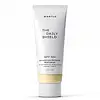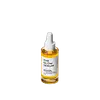What's inside
What's inside
 Key Ingredients
Key Ingredients

 Benefits
Benefits

 Concerns
Concerns

 Ingredients Side-by-side
Ingredients Side-by-side

Water
Skin ConditioningDibutyl Adipate
EmollientBis-Ethylhexyloxyphenol Methoxyphenyl Triazine
Skin ConditioningDiethylamino Hydroxybenzoyl Hexyl Benzoate
UV FilterEthylhexyl Salicylate
UV AbsorberEthylhexyl Triazone
UV AbsorberDicaprylyl Ether
EmollientPolymethyl Methacrylate
Glycerin
HumectantCetearyl Alcohol
EmollientUndecane
EmollientC15-19 Alkane
SolventSynthetic Fluorphlogopite
Disodium Cetearyl Sulfosuccinate
CleansingCannabis Sativa Leaf Extract
EmollientTocopheryl Acetate
AntioxidantSaccharide Isomerate
HumectantHelianthus Annuus Seed Oil
EmollientCaprylic/Capric Triglyceride
MaskingGlyceryl Stearate
EmollientTocopherol
AntioxidantHippophae Rhamnoides Fruit Extract
Skin ConditioningRosmarinus Officinalis Leaf Extract
AntimicrobialSqualene
EmollientGlycine Soja Oil
EmollientBeta-Sitosterol
Emulsion StabilisingTridecane
PerfumingXanthan Gum
EmulsifyingAminomethyl Propanol
BufferingSodium Laureth Sulfate
CleansingLauroyl Lysine
Skin ConditioningPhenoxyethanol
PreservativeEthylhexylglycerin
Skin ConditioningSodium Citrate
BufferingCitric Acid
BufferingWater, Dibutyl Adipate, Bis-Ethylhexyloxyphenol Methoxyphenyl Triazine, Diethylamino Hydroxybenzoyl Hexyl Benzoate, Ethylhexyl Salicylate, Ethylhexyl Triazone, Dicaprylyl Ether, Polymethyl Methacrylate, Glycerin, Cetearyl Alcohol, Undecane, C15-19 Alkane, Synthetic Fluorphlogopite, Disodium Cetearyl Sulfosuccinate, Cannabis Sativa Leaf Extract, Tocopheryl Acetate, Saccharide Isomerate, Helianthus Annuus Seed Oil, Caprylic/Capric Triglyceride, Glyceryl Stearate, Tocopherol, Hippophae Rhamnoides Fruit Extract, Rosmarinus Officinalis Leaf Extract, Squalene, Glycine Soja Oil, Beta-Sitosterol, Tridecane, Xanthan Gum, Aminomethyl Propanol, Sodium Laureth Sulfate, Lauroyl Lysine, Phenoxyethanol, Ethylhexylglycerin, Sodium Citrate, Citric Acid
Caprylic/Capric Triglyceride
MaskingShea Butter Ethyl Esters
EmollientSqualane
EmollientC15-19 Alkane
SolventCannabis Sativa Seed Oil
EmollientOryza Sativa Bran Oil
EmollientTocopheryl Acetate
AntioxidantSalvia Hispanica Seed Oil
MoisturisingBakuchiol
AntimicrobialCannabis Sativa Leaf Extract
EmollientGlycyrrhiza Glabra Root Extract
BleachingTocopherol
AntioxidantGlycine Soja Oil
EmollientBeta-Sitosterol
Emulsion StabilisingSqualene
EmollientBisabolol
MaskingHelianthus Annuus Seed Oil
EmollientCanola Oil
EmollientDaucus Carota Sativa Seed Oil
EmollientDaucus Carota Sativa Root Extract
Skin ConditioningBeta-Carotene
Skin ConditioningCaprylic/Capric Triglyceride, Shea Butter Ethyl Esters, Squalane, C15-19 Alkane, Cannabis Sativa Seed Oil, Oryza Sativa Bran Oil, Tocopheryl Acetate, Salvia Hispanica Seed Oil, Bakuchiol, Cannabis Sativa Leaf Extract, Glycyrrhiza Glabra Root Extract, Tocopherol, Glycine Soja Oil, Beta-Sitosterol, Squalene, Bisabolol, Helianthus Annuus Seed Oil, Canola Oil, Daucus Carota Sativa Seed Oil, Daucus Carota Sativa Root Extract, Beta-Carotene
Ingredients Explained
These ingredients are found in both products.
Ingredients higher up in an ingredient list are typically present in a larger amount.
Beta-Sitosterol is a plant-derived fatty acid with a structure similar to cholesterol (which naturally occurs in skin). It helps hydrate the skin and stabilize formulations.
This ingredient can be naturally found in fruits, veggies, nuts, and seeds.
C15-19 alkane is a mixture of alkanes. Alkanes are hydrocarbons with carbon atoms held together by single bonds.
It is a synthetically created solvent and emollient often used to replace silicones or mineral oil. As an emollient, C15-19 Alkane helps soften and soothe the skin. Emollients create a barrier to trap moisture inside.
C15-19 Alkane is often used with mineral UV filters such as titanium dioxidide and zinc oxide. It helps these UV filter ingredients be more spreadable.
C15-19 Alkane is biodegradable.
Learn more about C15-19 AlkaneWe don't have a description for Cannabis Sativa Leaf Extract yet.
This ingredient is an emollient, solvent, and texture enhancer. It is considered a skin-softener by helping the skin prevent moisture loss.
It helps thicken a product's formula and makes it easier to spread by dissolving clumping compounds.
Caprylic Triglyceride is made by combining glycerin with coconut oil, forming a clear liquid.
While there is an assumption Caprylic Triglyceride can clog pores due to it being derived from coconut oil, there is no research supporting this.
Learn more about Caprylic/Capric TriglycerideGlycine Soja Oil comes from the soybean. Glycine Soja is native to eastern Asia.
Soybean oil is an emollient. It is rich in antioxidants and fatty acids including palmitic, stearic, oleic, and linoleic acids.
As an emollient, the fatty acids in soybean oil helps keep your skin soft and hydrated. It does so by creating a film on top that traps moisture in.
Soybean oil is also rich in vitamin E, a potent antioxidant. Vitamin E is also anti-inflammatory and provides a soothing effect.
Studies show soy may help fade hyperpigmentation from UVB. It does so by disrupting the melanin process from UVB induced skin inflammation.
This ingredient may not be malassezia folliculitis, or fungal-acne, safe.
Soybeans are rich in proteins and are part of the legume family. Foods made with soybeans include tofu, soymilk, edamame, miso, and soy sauce.
Learn more about Glycine Soja OilHelianthus Annuus Seed Oil is the oil derived from the seeds of a Sunflower. Sunflower seed oil is non-fragrant. It is an emollient, meaning it helps to soften the skin.
Sunflower seed oil contains many fatty acids. The fatty acids found in sunflower seeds include (from highest amount to least): linoleic acid, myristic acid, palmitic acid, stearic acid, arachidic acid, oleic acid, and linolenic acid.
These fatty acids help the skin create ceramides. Ceramides play a role in repairing the skin barrier.
Helianthus Annuus Seed Oil helps moisturize the skin. This in turn helps the skin look more rejuvenated and smoother.
Sunflowers are rich in vitamin E.
Historians believe Indigenous cultures of North America domesticated sunflowers before corn. Thus they relied on sunflower oil for a variety of uses. One such use is moisturizing skin and hair.
Sunflower seed oil may not be fungal acne safe. We recommend speaking with a professional if you have any concerns.
Learn more about Helianthus Annuus Seed OilSqualene is naturally found in plants and animals, including our skin and sebum. It is a lipid our bodies naturally produce and makes up about 10-12% of the oil on our skin. Our skin produces squalene to keep itself naturally hydrated.
This ingredient is a potent antioxidant and can help fight against skin damage.
Sources of squalene include olives and rice bran. Some sources may be animals such as from shark liver.
Squalane comes from squalene and is created using hydrogenation. Squalane is lighter than squalene.
Hydrogenation is the conversion from unsaturated oil to saturated oil. This makes squalane more stable and have a longer shelf life than squalene.
Read more about squalane with an "a".
Learn more about SqualeneTocopherol (also known as Vitamin E) is a common antioxidant used to help protect the skin from free-radicals and strengthen the skin barrier. It's also fat soluble - this means our skin is great at absorbing it.
Vitamin E also helps keep your natural skin lipids healthy. Your lipid skin barrier naturally consists of lipids, ceramides, and fatty acids. Vitamin E offers extra protection for your skin’s lipid barrier, keeping your skin healthy and nourished.
Another benefit is a bit of UV protection. Vitamin E helps reduce the damage caused by UVB rays. (It should not replace your sunscreen). Combining it with Vitamin C can decrease sunburned cells and hyperpigmentation after UV exposure.
You might have noticed Vitamin E + C often paired together. This is because it is great at stabilizing Vitamin C. Using the two together helps increase the effectiveness of both ingredients.
There are often claims that Vitamin E can reduce/prevent scarring, but these claims haven't been confirmed by scientific research.
Learn more about TocopherolTocopheryl Acetate is AKA Vitamin E. It is an antioxidant and protects your skin from free radicals. Free radicals damage the skin by breaking down collagen.
One study found using Tocopheryl Acetate with Vitamin C decreased the number of sunburned cells.
Tocopheryl Acetate is commonly found in both skincare and dietary supplements.
Learn more about Tocopheryl Acetate